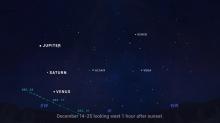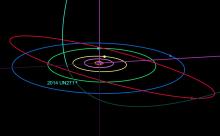Listen to today's episode of StarDate on the web the same day it airs in high-quality streaming audio without any extra ads or announcements. Choose a $8 one-month pass, or listen every day for a year for just $30.
You are here
Discovering Comets
Astronomers have cataloged thousands of comets — balls of rock and ice that sprout long tails when they get close to the Sun. Some of them have been known for centuries. But most of them were discovered only recently.
For a long time, finding comets was one of the main goals of every astronomer. Discovering a comet brought fame, job security, and even medals.
By the 20th century, though, comet-hunting had become a job for the amateurs. They tagged anywhere from a handful to perhaps a dozen or so every year.
Late in the century, though, astronomers began launching automated searches for comets and asteroids. The searches were designed to spot objects that might someday endanger Earth. But they’ve found comets and asteroids all across the solar system.
Most of the asteroids are in a broad band between the orbits of Mars and Jupiter. But the comets come from much farther out, so there aren’t many of them in the inner solar system.
The champion comet-hunter wasn’t designed to look for comets at all. Instead, a satellite named SOHO keeps an eye on the space around the Sun. It’s watching what happens in the Sun’s outer atmosphere.
Comets often swing close to the Sun. That makes them easy pickin’s for SOHO. Some of the comets flare brightly, then retreat to the outer solar system. But others vaporize under the Sun’s intense heat. So many of the comets seen by SOHO vanished almost as soon as they were discovered.
More about comets tomorrow.
Script by Damond Benningfield






